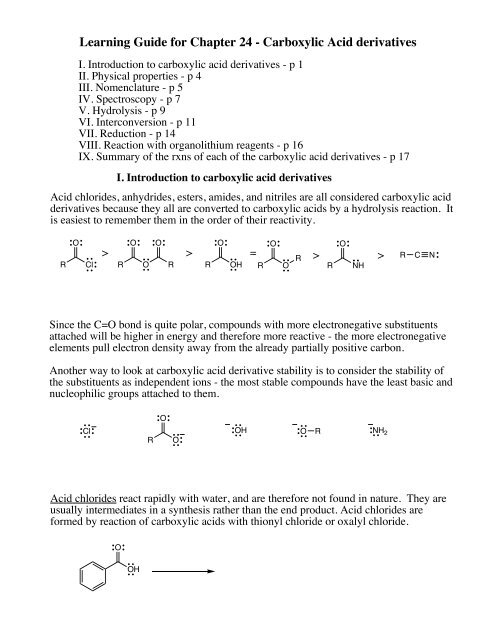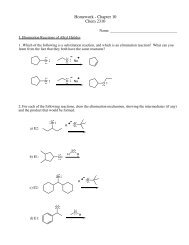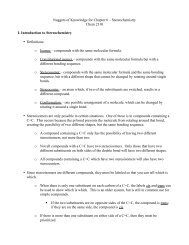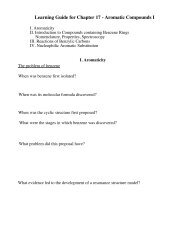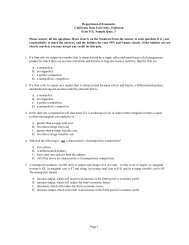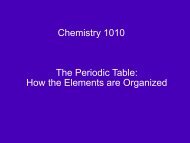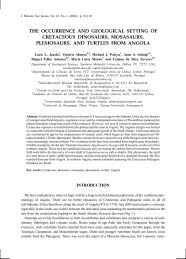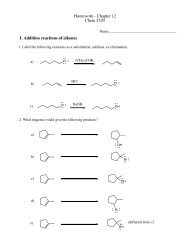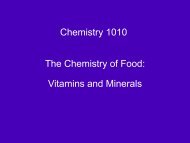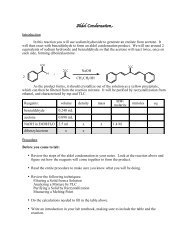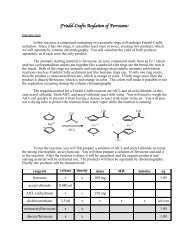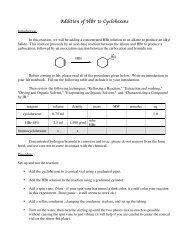Learning Guide for Chapter 24 - Carboxylic Acid derivatives
Learning Guide for Chapter 24 - Carboxylic Acid derivatives
Learning Guide for Chapter 24 - Carboxylic Acid derivatives
- No tags were found...
You also want an ePaper? Increase the reach of your titles
YUMPU automatically turns print PDFs into web optimized ePapers that Google loves.
<strong>Learning</strong> <strong>Guide</strong> <strong>for</strong> <strong>Chapter</strong> <strong>24</strong> - <strong>Carboxylic</strong> <strong>Acid</strong> <strong>derivatives</strong>I. Introduction to carboxylic acid <strong>derivatives</strong> - p 1II. Physical properties - p 4III. Nomenclature - p 5IV. Spectroscopy - p 7V. Hydrolysis - p 9VI. Interconversion - p 11VII. Reduction - p 14VIII. Reaction with organolithium reagents - p 16IX. Summary of the rxns of each of the carboxylic acid <strong>derivatives</strong> - p 17I. Introduction to carboxylic acid <strong>derivatives</strong><strong>Acid</strong> chlorides, anhydrides, esters, amides, and nitriles are all considered carboxylic acid<strong>derivatives</strong> because they all are converted to carboxylic acids by a hydrolysis reaction. Itis easiest to remember them in the order of their reactivity.ROClOOR O RRO> > => >OHROORRONHR C NSince the C=O bond is quite polar, compounds with more electronegative substituentsattached will be higher in energy and there<strong>for</strong>e more reactive - the more electronegativeelements pull electron density away from the already partially positive carbon.Another way to look at carboxylic acid derivative stability is to consider the stability ofthe substituents as independent ions - the most stable compounds have the least basic andnucleophilic groups attached to them.OClROOH O R NH 2<strong>Acid</strong> chlorides react rapidly with water, and are there<strong>for</strong>e not found in nature. They areusually intermediates in a synthesis rather than the end product. <strong>Acid</strong> chlorides are<strong>for</strong>med by reaction of carboxylic acids with thionyl chloride or oxalyl chloride.OOH
LG Ch <strong>24</strong> p 2Anhydrides are less reactive than acid chlorides and are occasionally found in nature. Anexample is cantharidin, the biological defense mechanism of a blister beetle. It causesblisters on the skin, and can be fatal to horses if they eat hay containing the beetles.Acetic anhydride is used in large quantities in industry <strong>for</strong> the synthesis of plastics, fibers,and drugs.OOOOcantharidinOOOacetic anhydrideAnhydrides are <strong>for</strong>med from carboxylic acids by using a strong dehydrating agent such asP 4 O 10 , or by heating diacids which <strong>for</strong>m 5- or 6-membered cyclic anhydrides. They canalso be made from acid chlorides, as we shall see.2OOHP 4 O 10OOHOHheatOEsters are very common in nature. Many pleasant odors and flavors come from esters,such as isopentyl acetate (banana oil) and geranyl acetate (found in roses, geraniums, andother flowers). Oil of wintergreen contains methyl salicylate. Several widely usedpolymers can be made by joining molecules together with ester linkages. Cyclic estersare called lactones - ascorbic acid (vitamin C) is an example.OOOOOisopentyl acetatePET - used to make polyester cloth,film <strong>for</strong> video tapes, and plastic bottlesOOgeranyl acetateOOOOOOOHOOHOHO OHOOascorbic acid
Esters can be <strong>for</strong>med from carboxylic acids and alcohols by Fischer esterification, byreaction with diazomethane, or by deprotonation followed by a reactive alkyl halide.They can also be <strong>for</strong>med from acid chlorides and anhydrides, as we shall see.OOOOHOHLG Ch <strong>24</strong> p 3H 2 SO 4+OHCH 2 N 2K 2 CO 3OHCH 3 BrAmides are among the most stable of the carboxylic acid <strong>derivatives</strong>. They are referredto a primary, secondary, and tertiary in the same way that amines are. An example of atertiary amide is DEET, an effective insect repellant. Cyclic amides are called lactams,and are found in a number of biological molecules such as penicillin G. Amides can alsobe made into polymers, both artificial and natural. Proteins are the most importantexamples of natural amide polymers.ON,N-diethyltoluamide (DEET)Npenicillin GOOHNONOSOHH 2 NONHSHOHNONHOHNOSHOHa polypeptideAmides may be <strong>for</strong>med from carboxylic acids by heating the acid and amine together todrive off water. This reaction is commonly used in industry. In the laboratory, amidesare more often <strong>for</strong>med from amines and acid chlorides, as we saw in Ch 19. Amides canalso be made from anhydrides and esters, as we shall see.OOHNH 2heatOClNH 2pyridine
LG Ch <strong>24</strong> p 4Nitriles are <strong>for</strong>med from the reaction of cyanides with primary alkyl haldies or tosylatesor from diazonium ions reacting with cuprous cyanide.BrNaCNOTsNaCNNH 2 HNO 2CuCNII. Physical properties of carboxylic acid <strong>derivatives</strong>Esters have low boiling points, about the same as hydrocarbons of the same molecularweight. Nitriles are similar to alcohols - the strength of the dipole attractions is similar tothe hydrogen bonding attractions of alcohols. Amides, however, are higher boiling thancarboxylic acids. Primary amides are higher than secondary amides, which are higheragain than tertiary amides because of the decreasing possibility <strong>for</strong> hydrogen bonding.OOOOCOHOHNH 2NNHHONOONH 2All carboxylic acid <strong>derivatives</strong> are soluble in organic solvents such as alcohols, ethers,chlorinated hydrocarbons, and aromatic hydrocarbons. <strong>Acid</strong> chlorides and anhydridescannot be dissolved in water because they will react with it. Some small amides, esters,and nitriles are soluble in water. Ethyl acetate, N,N-dimethyl<strong>for</strong>mamide, and acetonitrileare often used as reaction solvents.OOHONH 3 C C N
LG Ch <strong>24</strong> p 5III. Nomenclature of carboxylic acid <strong>derivatives</strong>The names of the carboxylic acid <strong>derivatives</strong> are based on the name of the parentcarboxylic acid. The common names of <strong>for</strong>mic acid and acetic acid are always used in<strong>for</strong> one and two carbon chains.All carboxylic acid <strong>derivatives</strong> are principle groups. They have less priority thancarboxylic acids, but more than aldehydes. <strong>Acid</strong> chlorides and anhydrides rarely occur inthe same compound with other functional groups, so you don't have to worry about themin the ranking. Esters and amides can be named as substituents, but it's quitecomplicated, and you won't be responsible to do so.COOH > esters / amides > nitriles > aldehydes > ketones > alcohols > amines<strong>Acid</strong> chlorides - drop "ic acid" from the name of the parent carboxylic acid, and add"yl chloride."OClOClOClClO<strong>Acid</strong> anhydrides - change the word "acid" in the parent name to "anhydride." With mixedanhydrides, use the names of both parent acids.OOOOOOHOOOOOOOOO
LG Ch <strong>24</strong> p 6Esters - name the group attached to the O as a substituent, then drop "ic acid" from thename of the parent acid and add "ate."OOOOOOOOphenyl 2-methylpropanoatebutyl p-chlorobenzoateisopropyl <strong>for</strong>mate2-hydroxypropyl decanoateAmides - drop "ic acid" or "oic acid" and add "amide" to the parent name. Groups on thenitrogen are treated as N-substituents.OONH 2NONO 2 NONH 2
3-chloro-N-methylpentanamideN-benzyl<strong>for</strong>mamideLG Ch <strong>24</strong> p 7Nitriles - drop "ic acid" from common names of acids and add "onitrile." With regularacid names, go back to the full alkane name and add "nitrile." When a higher prioritygroup is present, name as a cyano substituent.H 3 C C NNONOHNNNIV. Spectroscopy of carboxylic acid <strong>derivatives</strong>IR - All of the carboxylic acid <strong>derivatives</strong> have a C=O band, each at a characteristicfrequency. When conjugated to a benzene ring or C=C, the frequency is always shifted toa lower wavenumber.Anhydride - two C=O absorbtions at 1760, 1820 cm -1 .
LG Ch <strong>24</strong> p 8Esters - C=O at 1735 cm -1C-O at 1000-1300 cm -1-1Amides - C=O at 1650 cmN-H 3200-3400 cm -1 (2 <strong>for</strong> primary, 1 <strong>for</strong> secondary, none <strong>for</strong> tertiary)NH 2 scissor sometimes overlaps C=ONitriles - triple bond at 2260-2200 cm -1NMR - protons on C's next to C=O's are around 2.0-2.5 ppm <strong>for</strong> all functional groupsprotons on C's next to O's are between 3-4 ppm in alcohols, ethers, and estersprotons on C's next to N's are between 2.5 and 3.0 <strong>for</strong> amines and amidesamide H's are variable, but usually appear between 5-8 ppm and exchange w/D 2 OH's on C=O's are about 9-11 ppm <strong>for</strong> aldehydes, 8 ppm <strong>for</strong> <strong>for</strong>mic acid <strong>derivatives</strong>OOH 3 C C NONHOH NH 2
V. Hydrolysis of carboxylic acid <strong>derivatives</strong>LG Ch <strong>24</strong> p 9All carboxylic acid <strong>derivatives</strong> can be hydrolyzed to <strong>for</strong>m carboxylic acids. The word"hydrolysis" comes from "hydro" meaning water and "lysis" meaning to cut, implyingthat these compounds are cut with water.<strong>Acid</strong> chlorides, anhydrides - react easily with water. Reactions involving these functionalgroups must be kept dry in order to avoid this side reaction. During the work-up thereaction is quenched with water and the acid chloride or anhydride undergoes hydrolysis.The mechanism <strong>for</strong> both of these reactions follows the typical pattern <strong>for</strong> carboxylic acid<strong>derivatives</strong>. The nucleophile attacks and the C=O electrons are pushed up; then theelectrons come back down and push off a chloride or carboxylate ion. A water moleculeor carboxylate ion then comes back and deprotonates the OH.OClHOHOOHOHOEsters, amides and nitriles do not simply react with water - they must be activated by acidin the presence of water or attacked by hydroxide in order to be hydrolyzed, and eitherreaction must be heated. Esters are the easiest to hydrolyze; amides require muchstronger acid or base, and nitriles likewise require strenous conditions.Esters - acid-catalyzed hydrolysis is the opposite of the Fischer esterification. It has anequilibrium constant near 1 and must be driven <strong>for</strong>ward by using water as the solvent orremoval of the resulting alcohol.OOH 2 SO 4HOH
LG Ch <strong>24</strong> p 10Base-catalyzed hydrolysis of esters is called saponification. It is not reversible because ofthe last acid-base reaction at the end.OOHOHOHThe term saponification comes from the original use of this reaction in making soap.Recall that saturated fats are triesters of long chain fatty acids and glycerol.Saponification yields the carboxylate anions of these fatty acids, which arrangethemselves as micelles and are good <strong>for</strong> dissolving dirt and grease. Base was obtainedfrom water soaked in wood ashes.OOOOOONaOHH 2 Oheat+HO3OHOHOONaAmides - require strongly acidic or basic conditions such as 6M HCl or 40% NaOH. Themechanisms are analogous to the ester mechanisms. Note that in both cases, theequilibrium is driven <strong>for</strong>ward by a final acid-base reaction.OH 2 SO 4NH 2H 2 OONH 2NaOHH 2 O
LG Ch <strong>24</strong> p 11Nitriles can be hydrolyzed to amides using mild acid or base. Under more strenousconditions, the amide is then hydrolyzed to the carboxylic acid. You will not need toknow these mechanisms - they are similar to the ones we've discussed, with a few extratwists.NH 3 O +H 2 O, heatNNaOHH 2 O, heatVI. Interconversion of carboxylic acid <strong>derivatives</strong>As a general rule, carboxylic acid <strong>derivatives</strong> can be converted into any other derivativethat is less reactive than the original. Esters can also be made into other esters by atransesterification reaction.carboxylic acidacid chloride anhydride ester amideThe only way to go from a more reactive to a less reactive derivative is to first hydrolyzeto the carboxylic acid.OOONH 2OHOThe general mechanism <strong>for</strong> converting a more reactive derivative into a less reactive oneis shown below. If the Nu originally had an H attached, it will be removed in anadditional step.ONuLGWhen making anhydrides, the nucleophile is a carboxylate anion. When making esters,the nucleophile may be an alcohol or an alkoxide. When making amides, the nucleophileis ammonia or an amine.OOOOR O RRORRNH
LG Ch <strong>24</strong> p 12<strong>Acid</strong> chlorides - can be converted to anhydrides, esters, and amides by reacting them withcarboxylate anions. alcohols, or amines. A non-nucleophilic base such as pyridine ortriethylamine is used as the base to pull off the H when making esters or amides.OClOOOOHClEt 3 NONH 2ClpyridineNote that this method allows us to make esters that can't be made directly fromcarboxylic acids, including tertiary and phenyl esters.OEt 3 NClOHAnhydrides - can be made into esters or amides by reacting with alcohols, ammonia, oramines. The carboxylate ion leaving group serves as the base to pull off the hydrogen atthe end, <strong>for</strong>ming a carboxylic acid as an additional product.OOOHOOONHO
LG Ch <strong>24</strong> p 13If a mixed anhydride is used, two sets of products are possible, depending on which C=Ois attacked.OOOOHA cyclic anhydride gives a compound with a carboxylic acid and an ester or amide whichwould otherwise be difficult to synthesize.OOONH 3Esters - can be converted to other esters or to amides. Amines are strong enoughnucleophiles to attack an ester, but alcohols are not. When converting an ester to anotherester (called a transesterification), the ester must be activated by acid or attacked by analkoxide. The mechanisms have the same steps as the hydrolysis of an ester.OOH 2 SO 4OHOOOOHOONH 2
LG Ch <strong>24</strong> p 14When hydroxylamine is used as the nucleophile, the product <strong>for</strong>ms a colored complexwith Fe +3 ions - this is the basis of the hydroxamate test <strong>for</strong> esters.OH 2 NOHOPractice:OOHClpyridineOObenzylamineheatOONH 3OOOH 2 SO 4OHVII. Reduction of carboxylic acid <strong>derivatives</strong><strong>Carboxylic</strong> acid <strong>derivatives</strong> can be reduced to <strong>for</strong>m alcohols, aldehydes, or amines. Allcarboxylic acid <strong>derivatives</strong> require LiAlH 4 to be completely reduced.<strong>Acid</strong> chlorides and anhydrides can be reduced to alcohols by lithium aluminum hydride,but since they are made from carboxylic acids which can also be reduced to alcohols, thisis a pretty much a wasted step.OOHLiAlH 42. H 3 O +
LG Ch <strong>24</strong> p 15<strong>Acid</strong> chlorides can be reduced to aldehydes by a less active <strong>for</strong>m of lithium aluminumhydride, as we have seen previously.OClLiAlH(O-tBu) 3Esters are reduced by lithium aluminum hydride to <strong>for</strong>m two alcohols.OOLiAlH 42. H 3 O +Amides and nitriles are both reduced by lithium aluminum hydride to <strong>for</strong>m amines.Nitriles may also be reduced using catalytic hydrogenation.ONLiAlH 42. H 2 ONLiAlH 42. H 2 ONH 2 , Pd/CPractice - what compounds could be reduced with what reagents to give the following?OH+OHHNOH
LG Ch <strong>24</strong> p 16VIII. Addition of organometallic reagents to carboxylic acid <strong>derivatives</strong>Grignard or organolithioum reagents add to acid chlorides or esters to give tertiaryalcohols in which the organometallic R group has been substituted twice. In the firststep, a ketone is <strong>for</strong>med which then reacts again.OO22. H 3 O +MgBrO2LiCl2. H 3 O +Primary and secondary amides cannot be attacked by organometallic reagents becausethey are acidic. The organometallic reagent simply acts as a base to deprotonate theamide.OMgBrNH 2Nitriles are attacked by organometallic reagents to <strong>for</strong>m the conjugate base of an imine.Upon hydrolysis, a ketone or aldehyde is <strong>for</strong>med.NMgBrH 2 OH 3 O +
LG Ch <strong>24</strong> p 17IX. Summary of reactions of carboxylic acid <strong>derivatives</strong>acid chloride anhydride ester amide nitrilehydrolysisreductionorganometallicreagentcarboxylatealcoholamine


